What Would You Do If You Faced This Challenge
- On July 14, 2025
- marketing challenges china
Your brand might be thriving globally, but as you eye China, a market with a vast digital ecosystem and unique cultural nuances, have you ever considered that a seemingly harmless marketing campaign could instantly unravel years of effort and even lead to a catastrophic brand reputation crisis? When it truly happens, what would you do?
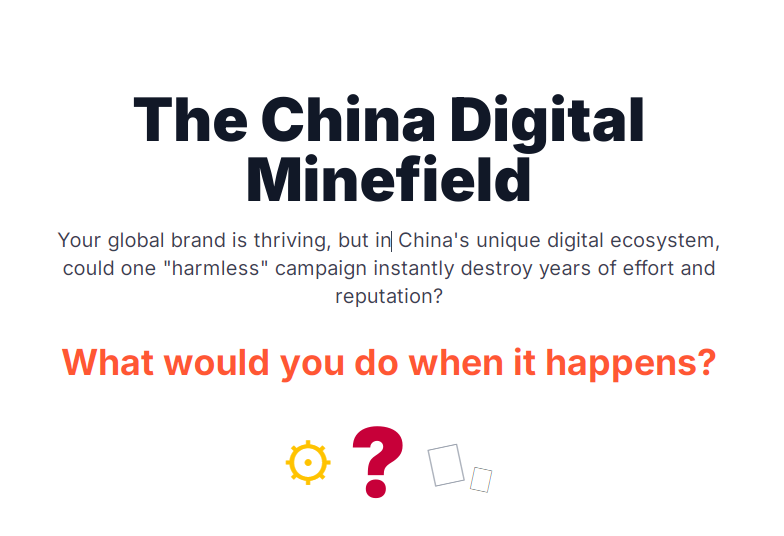
A Real-Life Debacle: Dolce & Gabbana’s “Great Fall” in China
In the Western business world, many are familiar with the “Waterloo” incident of Italian luxury brand Dolce & Gabbana (D&G) in China. This is a vivid example of the devastating consequences that a lack of cultural understanding can bring.
The story unfolded in 2018 when D&G planned to host a lavish fashion show in Shanghai, aiming to further expand its presence in China’s immensely promising luxury market. To build anticipation, they released a series of meticulously produced promotional videos.

The scenes in the videos were intended to blend Eastern aesthetics with Western fashion, but the execution sparked outrage: an Asian model awkwardly struggled to eat Italian food like pizza and pasta with chopsticks, while the narration was deemed sarcastic and laden with stereotypical, “instructive” tones.
The brand might have believed this was a humorous cultural fusion, hoping to showcase its “global” creativity and inclusivity. They likely imagined Chinese consumers would find it novel or even amusing, or at least harmless. However, they clearly overlooked the deep-seated sensitivity of Chinese consumers regarding cultural pride and respect. Within the Chinese cultural context, this “humor” was quickly interpreted as arrogance, ignorance, and even an overt mockery of Chinese traditional culture.
Anger on social media spread like wildfire, rapidly going viral on short-video platforms (like Douyin) and social media (like Weibo and WeChat). Many Chinese netizens felt offended and insulted, and the brand’s comment sections were instantly flooded with negative sentiment. The conflict escalated rapidly, and D&G’s brand image in China began to crumble.
Even more destructive was the exposure of brand co-founder and designer Stefano Gabbana’s allegedly insulting remarks about China on social media, which completely ignited an already volatile public opinion bomb. The appearance of these comments rendered all of D&G’s previous explanations pale and exposed their arrogance and prejudice.
What followed was an unprecedented collective boycott: numerous Chinese celebrities and supermodels who were scheduled to attend the show withdrew en masse, e-commerce platforms swiftly removed all D&G products, and Chinese consumers launched a massive boycott movement. That highly anticipated Shanghai show was ultimately forced to cancel amidst immense controversy.
A once-coveted luxury brand became a pariah overnight, its future in the Chinese market shrouded in deep uncertainty. As an overseas business owner and marketer, seeing news like this, do you feel a profound fear and worry that your own brand might suffer a similar fate due to a moment of carelessness? D&G eventually released an apology video, but the severe damage to its brand image in China has yet to be fully recovered.
Decoding the Marketing Strategy: What Went Wrong (and What’s Right by Contrast)
The D&G incident serves as a classic cautionary tale, with significant flaws in its marketing strategy and activities across multiple dimensions:
What Went Wrong (The Pitfalls):
Cultural Misinterpretation and Arrogance:
- Forced Cultural Symbol Juxtaposition: D&G’s advertisement directly combined chopsticks, a traditional Chinese eating utensil, with Italian food in an awkward and seemingly mocking manner. This approach, ostensibly “fusion,” actually revealed a superficial understanding and disrespect for traditional Chinese culture.
- Assumed Humor vs. Actual Insult: The brand wrongly assumed its advertising’s “humor” would be accepted by Chinese consumers. In reality, this content was perceived as demeaning and ridiculing Chinese culture. This self-important attitude was more damaging than mere ignorance.
Lack of Deep Localized Insight:
- Centralized Decision-Making Detached from Local Context: The brand’s marketing decisions were likely made at its Italian headquarters, lacking in-depth understanding of China’s local market culture, values, and consumer sentiments. This led to content that was entirely out of touch, failing to resonate with the sensitive nerves of Chinese consumers.
- Neglecting Cultural Experts and Experienced Talent: A successful marketing campaign in China requires the involvement of seasoned local cultural experts and experienced marketing professionals in content creation and review. D&G clearly failed to leverage such professional resources.
Catastrophic Crisis Public Relations Missteps:
Personal Remarks Fueling the Fire: With negative public sentiment already brewing, the brand designer’s personal insulting remarks further exacerbated the conflict, escalating a mere marketing blunder into a full-blown brand crisis. This reflected the brand’s internal lack of awareness regarding cultural risks and poor management of executive communications.
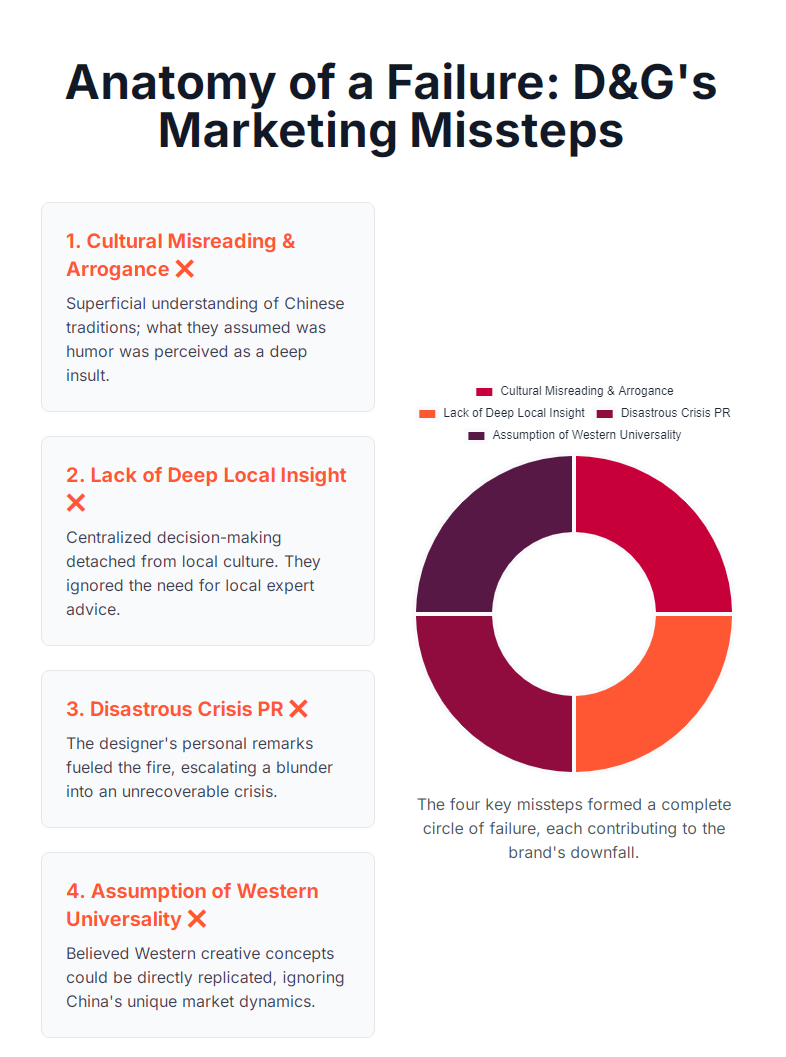
Assumption of Western Universality:
Lack of Adaptability: D&G mistakenly believed that humor or creativity successful in Western markets could be directly replicated in China. They failed to recognize the distinctiveness of the Chinese market in terms of culture, social media ecosystem, and consumer behavior.
What’s Right by Contrast (Lessons from Success):
By examining D&G’s missteps, we can learn from the experiences of other successful brands:
- McDonald’s and KFC’s Deep Localization: The success of these fast-food giants in China stems from their profound understanding of local consumer tastes and culture. McDonald’s not only localized its food (e.g., the pronunciation of “cheeseburger” resembling “immediately” for marketing), but KFC even introduced localized products like fried starfish, demonstrating acute insight into Chinese consumer demand.
- Oreo’s Creative Integration: Oreo successfully integrated into Chinese culture and boosted sales by launching localized flavors (like lychee) and packaging that incorporated elements of traditional Chinese festivals like Chinese New Year.
- Haribo’s Global and Local Balance: This candy brand, while maintaining its iconic rhyming slogans in European markets, adapted specific words for different languages, achieving a perfect cultural fit while preserving global brand recognition.
- Starbucks’ Emotional Resonance: Starbucks cleverly tapped into the “886” work culture (8 AM to 8 PM, six days a week) prevalent among young Chinese professionals in its marketing, launching coffee products that resonated through humor and understanding.
- Lego’s Consumer Engagement: Lego has been highly successful in China by involving consumers in its advertising and marketing activities, creating more immersive and interactive content that deeply integrates into Chinese consumers’ lives.
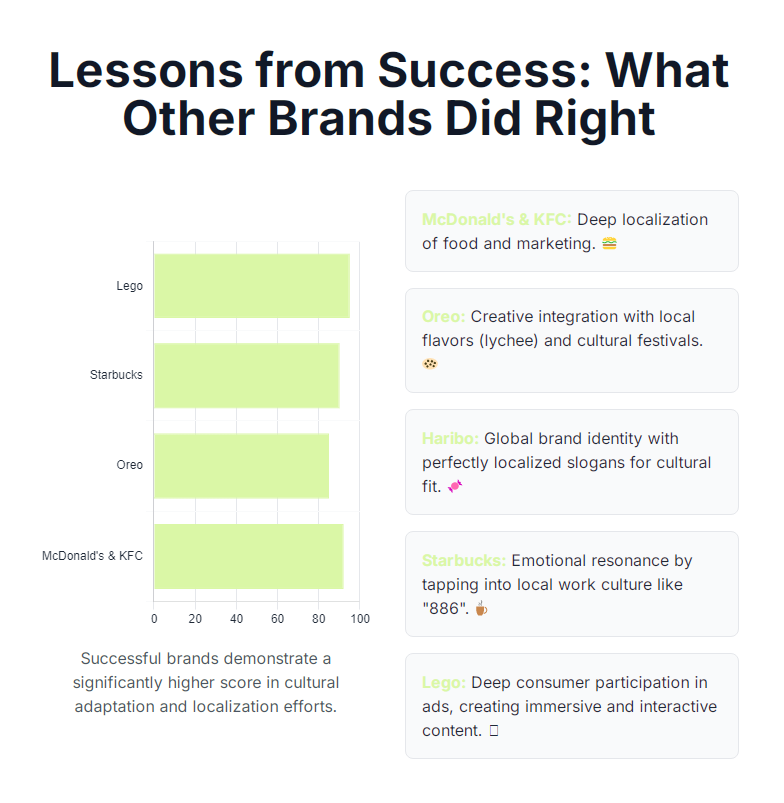
Lessons Learned: Illuminating the Path Forward
The D&G case provides invaluable lessons for all Western enterprises aiming to enter the Chinese market, particularly manufacturing companies. It serves as a stark reminder that while pursuing market opportunities, one must be acutely aware of potential cultural and political landmines:
China Market’s Uniqueness and Sensitivity:
- Cultural Red Lines Must Not Be Crossed: China is a country with a long history and deep cultural traditions. Its consumers hold a high degree of pride and sensitivity regarding their cultural identity and national sentiment. Any content, seemingly unintentional but in fact embodying stereotypes, discrimination, or mockery, can trigger massive backlash.
- Government and Public Alignment: On issues concerning national sovereignty (e.g., Taiwan, Hong Kong), history, or national dignity, the stance of the Chinese government and its populace is highly unified. Brands must have a clear understanding of this and ensure their words and actions align with local political correctness and cultural norms.
Cultural Insight Trumps Literal Translation (Transcreation):
- Deep Understanding in Content Creation: Do not simply translate Western marketing content into Chinese. Instead, engage in “cultural recreation” or transcreation. This means deeply understanding the nuances of Chinese culture, linguistic habits, and emotional expression to embed the brand’s core meaning and emotion into the local context.
- Professional Copywriting is Crucial: The role of a qualified Chinese copywriter or local marketing expert is far more important than any AI translation or general translation software. They can grasp the essence of the language and the connotations of the culture, avoiding misunderstandings caused by inappropriate expressions.
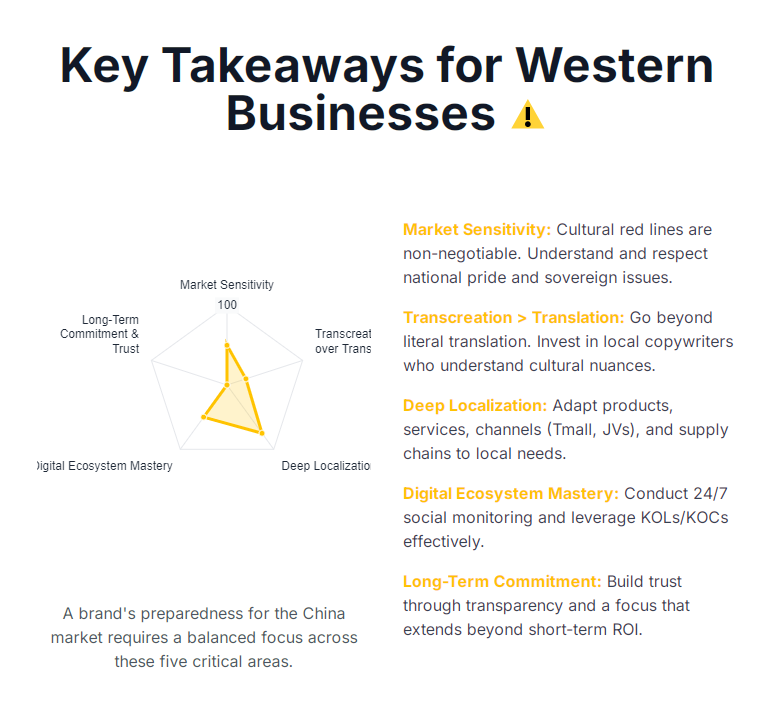
Localization as the Cornerstone of Success:
- Product and Service Adaptability: Manufacturing enterprises must localize not only in marketing but also in product design, functionality, and even taste (for fast-moving consumer goods) according to the unique demands of the Chinese market. This not only enhances product competitiveness but also demonstrates the brand’s respect for local consumers.
- Channel and Supply Chain Considerations: When entering the Chinese market, it’s crucial to plan channel strategies in detail, such as direct sales via Tmall Global, finding local partners to establish joint ventures, or setting up factories in free trade zones. Simultaneously, given the Chinese market’s price sensitivity, localized production and supply chain optimization are vital for reducing costs and enhancing competitiveness.
Immense Influence of Digital Ecosystem and Social Media:
- Public Opinion Monitoring and Rapid Response: China boasts the world’s most active and influential social media ecosystem. Once negative public sentiment erupts, its spread speed and influence are unimaginable in the West. Brands need to establish professional local teams for 24/7 public opinion monitoring and be able to provide appropriate and sincere responses at the first instance.
- Key Opinion Leaders (KOLs) and Key Opinion Consumers (KOCs): Consumer decisions in China are highly reliant on KOLs and KOCs on social media. Building genuine partnerships with them and leveraging their influence for authentic and credible communication is far more effective than traditional hard advertising.
Long-Term Commitment and Trust Building:
- Beyond Short-Term ROI: Successful entry into the Chinese market requires a long-term commitment, not just the pursuit of short-term return on investment. Building consumer trust is a lengthy and complex process, especially after a crisis of confidence.
- Transparent Operations: Ensuring all brand operations in China comply with local regulations and maintaining transparency in marketing will help build and maintain brand reputation.
Elevating the Discussion: Mastering Digital Marketing in China
D&G’s failure was not accidental but a direct consequence of an insufficient understanding of the deep complexities of the Chinese market. However, this doesn’t mean Western enterprises cannot succeed in China’s digital marketing landscape. On the contrary, China’s immense potential and unique digital ecosystem offer unprecedented opportunities for brands willing to deeply understand and adapt.
Successful Western companies conducting digital marketing in China need to approach it from a foundation of “cultural empathy,” viewing every marketing activity as an opportunity for deep dialogue with Chinese consumers.
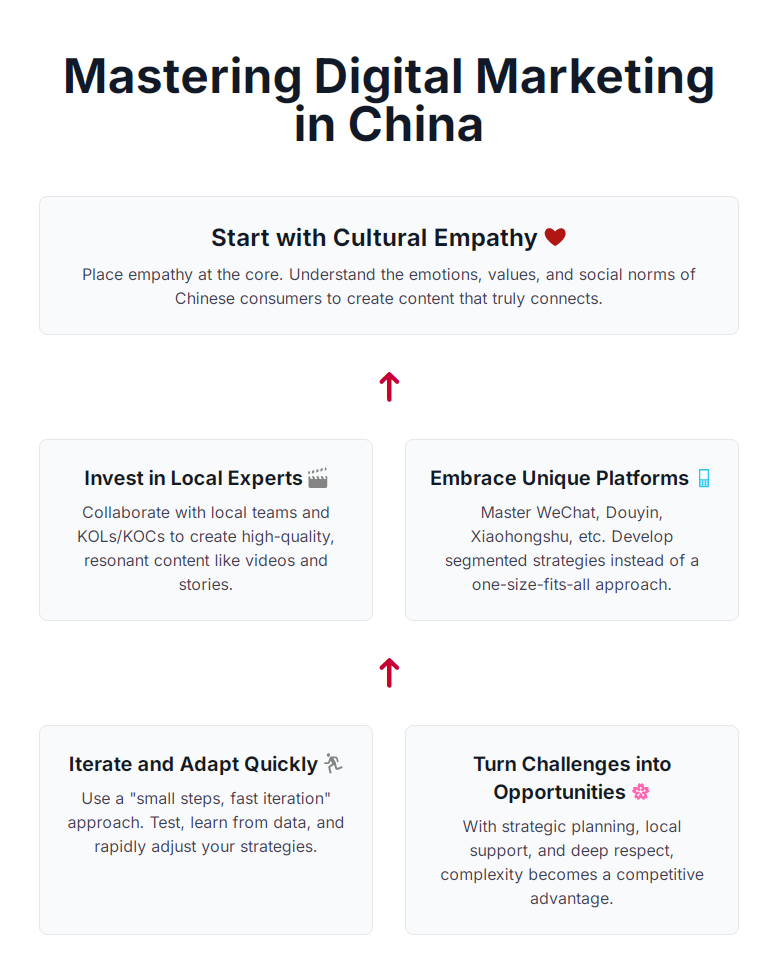
Implement “Cultural Empathy”-Driven Digital Marketing Strategies:
When conducting digital marketing in China, Western brands should place “cultural empathy” at their core, not just marketing techniques. This means not only understanding the target audience’s age, region, and behavioral habits, but also deeply comprehending their emotions, values, social norms, and cultural context. Only by truly understanding “why” Chinese consumers would feel joy or offense can genuinely touching content be created.
Invest in High-Quality Localized Content and Expert Teams:
Chinese consumers demand high-quality content, with video content increasingly becoming mainstream. Brands should collaborate with experienced local teams to create highly resonant, high-quality content, rather than merely aiming for quantity. This implies hiring copywriters, creatives, and operational talent who understand Chinese culture and the Chinese social media context, capable of translating brand philosophies into stories that resonate with Chinese audiences. Simultaneously, partnering with Key Opinion Leaders (KOLs) and Key Opinion Consumers (KOCs) to leverage their influence for authentic and credible communication often yields significantly better results.
Embrace China’s Unique Digital Platforms and Ecosystem:
Abandon the inertia of Western experience and deeply understand and fully utilize Chinese local digital platforms such as Baidu (search), WeChat (social, payments, mini-programs), Weibo (public opinion), Xiaohongshu (content e-commerce, “planting grass”) and Douyin (short video, live-stream e-commerce). These platforms boast massive user bases and unique marketing tools, with functions and user behavior patterns that differ significantly from Western platforms. Businesses need to formulate highly segmented and precise platform strategies based on their industry and target audience, rather than a “one-size-fits-all” approach to advertising.
“Small Steps, Fast Iteration” Strategy for Continuous Learning and Rapid Adaptation:
The Chinese market changes extremely rapidly, with regulations, consumer behavior, and platform trends constantly evolving. Brands need to maintain a flexible, open mindset and continuously conduct market research and “small-scale testing.” By testing digital ads with small budgets, collecting real user data and feedback, and quickly adjusting marketing strategies and product positioning, this “trial and error” spirit and rapid iteration capability are key to successful digital marketing in China.
Turn Challenges into Opportunities, Cultivating Deeply:
The complexity of the Chinese market is not an insurmountable obstacle; rather, it harbors immense opportunities. For manufacturing enterprises, through wise planning, professional local support, deep understanding of the digital ecosystem, and profound respect for culture, Western brands can absolutely overcome challenges. From product design to marketing promotion, integrating local wisdom at every step is crucial for achieving long-term and sustainable success in this largest consumer market globally. As successful brands demonstrate, with genuine commitment, patience, and wisdom, Chinese consumers will respond with the warmest embrace.

 Unlock 2025's China Digital Marketing Mastery!
Unlock 2025's China Digital Marketing Mastery!